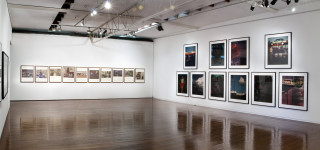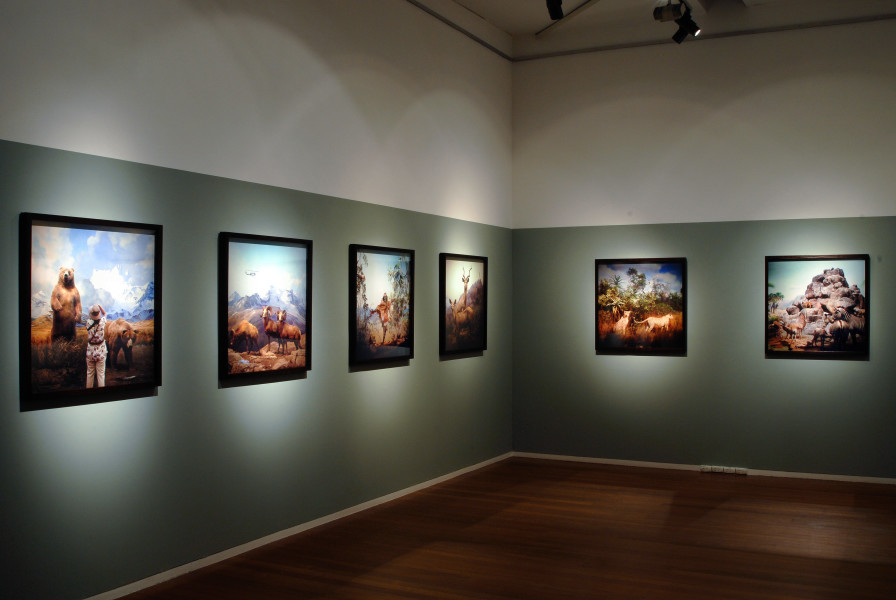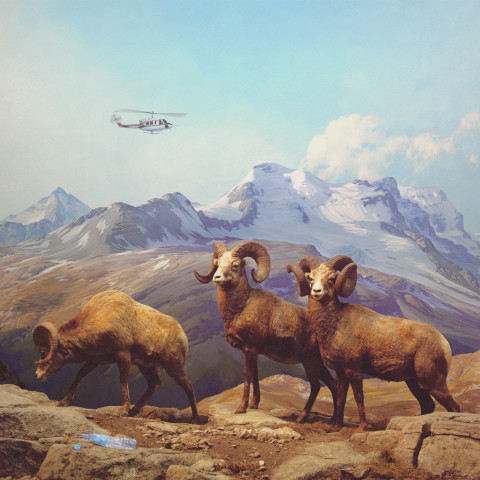Wild Life, presents ten high-gloss photographs featuring actual dioramas from the American Museum of Natural History in New York. Part readymade, and also a site for manipulation and intervention, Zahalka’s images of these famous dioramas bring into question the display practices of museums and the position of authority they reinforce with regard to knowledge, classification and collection.
Exhibition Dates: 1 February – 24 February 2007
‘The best thing, though, in that museum was that everything always stayed right where it was. Nobody’d move. You could go there a hundred thousand times […] Nobody’d be different. The only thing that would be different would be you..’.
—J.D.Salinger, The Catcher in the Rye
Anne Zahalka’s exhibition, Wild Life, presents ten high-gloss photographs featuring actual dioramas from the American Museum of Natural History in New York. Part readymade, and also a site for manipulation and intervention, Zahalka’s images of these famous dioramas bring into question the display practices of museums and the position of authority they reinforce with regard to knowledge, classification and collection. The world outside the museum has changed too however, with ready access to information and ease of travel. Why visit a museum when we can research via internet, watch re-enactments of dinosaur stampedes on TV, or pay for a spot on an eco-tour?
Wild Life marks a shift in the artist’s recent project, exploring human leisure pursuits and the ambivalent relationship that exists between the natural world and its artificial depictions, the real and the copy. Beginning with the 2004 series, Natural Wonders, Zahalka investigated the concept that tourists experience the natural world as a spectacle, as if nature is a performing thing that we can visit like an attraction—from specially built lookouts, to the reassurance of a guard rail, a reproduction in theme parks. Zahalka’s pseudo-objective stance critically examines how we seek out new experiences, while keeping the wild, or the uncontrollable real, at arms length.
You can’t get much more contrived than the museological diorama, the three-dimensional scenes of figures, taxidermied wildlife or other objects arranged in a naturalistic setting against a painted background. While they are designed to teach us about species through the presentation of an example in context, they often teach us a lot about how institutions interpret their role, responsibilities and interpretation of what audiences want.
The diorama framework encourages a belief in the authority of the museum’s knowledge, it’s selection, and theatrical simulation of the specially contrived habitat, the animal or bird posed just so to conjour delight, wonder, curiosity, excitement. Museum dioramas can reinforce our conceptions, like, ‘lions are the kings of the jungle’ for example. And because ideas like these are set-up in serious museums, the images are like a proof of themselves, and we believe things more (or perhaps do not question it as much as we could).
Science is illustrated by tapping into mythic stories that value-add to an exhibit—of the ‘Dr Livingstone, I presume’-type imaginings of ‘deepest, darkest Africa’, or the Indiana Jones style artifact hunter. The beautiful and compelling scenes are disrupted by the ethical, moral and ecological issues that Zahalka provokes. Jack Rabbit, with its links to plague-like profligacy cocks it’s head in one image, and turns its big ears in your direction. A ‘traditional’ Japanese woman surveys a snow-capped Fuji whilst a pheasant fossicks in the leaf litter. Titled Exotic Birds, 2006 we see how racism can be couched in the most sumptuous of guises.
Zahalka also raises a number of questions in relation to the representation of place, primitive and indigenous cultures and the study of wildlife within the scientific/anthropological realm of natural history. Of Birds of Australia, 2006 she writes that it, “…presents a living aboriginal man, performer Gnarnayarrahe Inmurry Waitairie pictured within a constructed Australian bush scene. He strikes a bird-like pose and performs his cultural identity like an object on display within this natural habitat diorama. The powerful presence of Gnarnayarrahe and his relationship to the land in this image makes a strong claim for his cultural place albeit within the constructed habitat of the museum.”
Actual dioramas allow some level of investigation by the viewer, in that we can move around and see the three-dimensional set from different angles. Zahalka’s current exhibition of photographs does not allow you to do this as easily. With the technical access to digital manipulation, the lines between what is really there and what an artist decides to include or erase makes the situation less simple. In Wild Life, we see that prints are able to equalize materials like fur, silk, ochre and grass—it all becomes just pigment on paper in the end—and the ability to seamlessly produce a new scenic ‘record’ allows Zahalka to slip complex issues into the flattened plane, where it is not so easy to distinguish where painted backdrops end and pictorial planes begin.
Zahalka intervenes in the ‘naturalism’ of the museum settings by the insertion of objects that while entirely plausible to current experiences of the real natural world (eg. litter, tourists, hunters, transport systems etc), brings home the fact that these things have no place within the museum presentation of a natural ideal. They are like red herrings in the natural world – and yet these scenes are increasingly just what we encounter, out there in nature. The ‘contemporary’ elements hijack an easy and unproblematic view of nature as it is seen behind the museum glass.
—Naomi Evans
—
Anne Zahalka has been exhibiting her photographs in Australia and overseas for over twenty years. Exhibitions of her two Leisureland series—Leisureland and Leisureland regional—have both toured extensively within Australia. In 2005 Anne Zahalka was the Winner of the Leopold Godowsky Photography Award, Boston. Recent international group exhibitions include Supernatural Artificialis (2004) at the Metropolitan Museum of Photography in Tokyo, Photographica Australis (2003) which toured Asia and at the Sala del Canal de Isabel II in Madrid (2002) toured by the Australian Centre for Photography. In 2003 Zahalka completed a major public art commission titled Welcome to Sydney for Sydney Airport. Major exhibitions within Australia include the survey show Photography: The 1980's at the National Gallery of Australia, Photography is Dead! Long Live Photography at the Museum of Contemporary Art, and Points of View: Australian Photography 1985 – 1995 at the Art Gallery of New South Wales, 2006. Her works are held in most major public collections in Australia as well as numerous private and corporate collections in Australia and overseas. The Centre of Contemporary Photography will be presenting a major survey exhibition of Zahalka’s work, Hall of Mirrors: Anne Zahalka Portraits 1987-2007, curated by Karra Rees from 23 March - 12 May 2007. Zahalka’s work will also be the subject of the Art Gallery of New South Wales’ Focus Room later this year. Wild Life will be Anne Zahalka’s sixth solo exhibition with Roslyn Oxley9 Gallery.
 Group Show, Head On Photography Festival
Group Show, Head On Photography Festival
Roslyn Oxley9 Gallery, 2011
 Anne Zahalka Playing the game!
Anne Zahalka Playing the game!
Roslyn Oxley9 Gallery, 2009
Anne Zahalka Hotel Suite
Melbourne Art Fair, 2008
Anne Zahalka Leisureland
Australian Embassy, Washington DC, 2007
 Anne Zahalka Wild Life
Anne Zahalka Wild Life
Roslyn Oxley9 Gallery, 2007
 Anne Zahalka Natural Wonders
Anne Zahalka Natural Wonders
Roslyn Oxley9 Gallery, 2004
Anne Zahalka Welcome To Sydney
Museum of Sydney, Sydney, 2002
 Group Show, The First 20 Years
Group Show, The First 20 Years
Roslyn Oxley9 Gallery, 2002
 Group Show, All Stars
Group Show, All Stars
Roslyn Oxley9 Gallery, 2000
Anne Zahalka Leisureland
Grafton Regional Gallery, 2000-01
 Anne Zahalka Leisureland
Anne Zahalka Leisureland
Roslyn Oxley9 Gallery, 2000
Anne Zahalka Woven threads II
Roslyn Oxley9 Gallery, 1998
 Group Show
Group Show
Roslyn Oxley9 Gallery, 1997
 Anne Zahalka Collectors
Anne Zahalka Collectors
Roslyn Oxley9 Gallery, 1996
 Group Show, Stockroom
Group Show, Stockroom
Roslyn Oxley9 Gallery, 1995
Anne Zahalka MFA Assessment show
Roslyn Oxley9 Gallery, 1994
 Anne Zahalka Gesture
Anne Zahalka Gesture
Roslyn Oxley9 Gallery, 1994
 Anne Zahalka Fortresses and Frontiers
Anne Zahalka Fortresses and Frontiers
Roslyn Oxley9 Gallery, 1993
Anne Zahalka Bondi: Playground of the Pacific
Bondi Pavilion, Sydney, 1989















